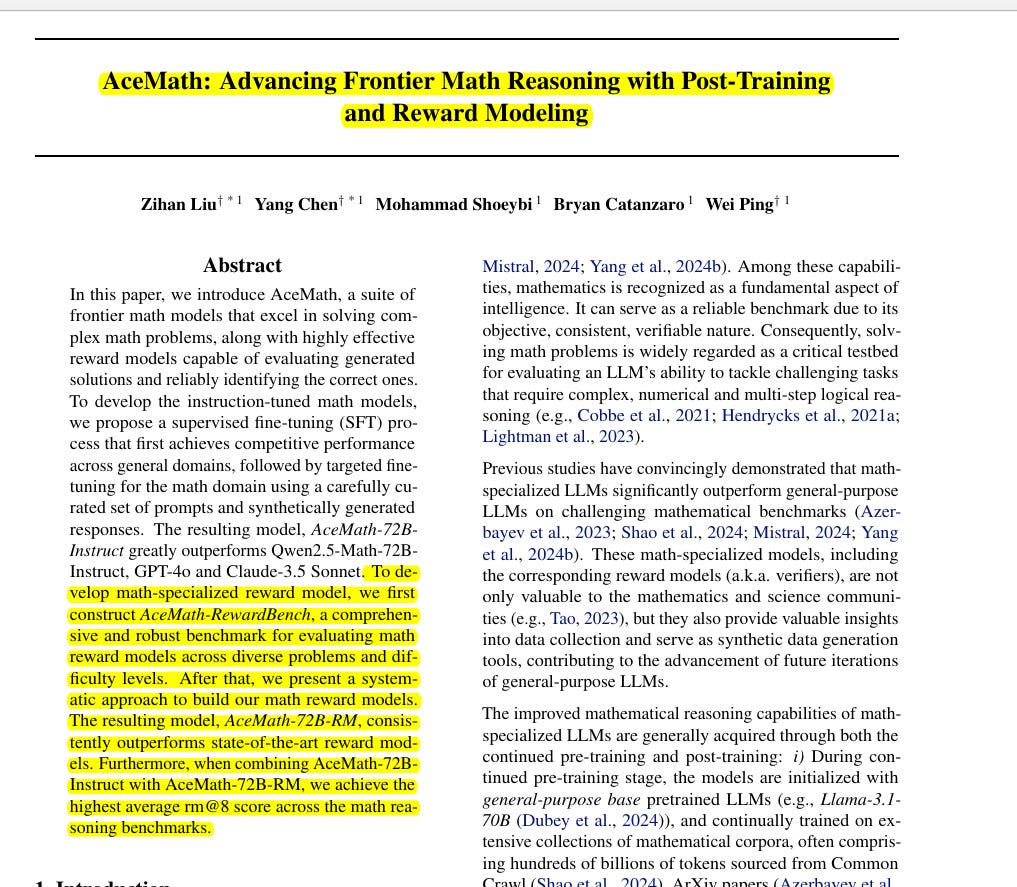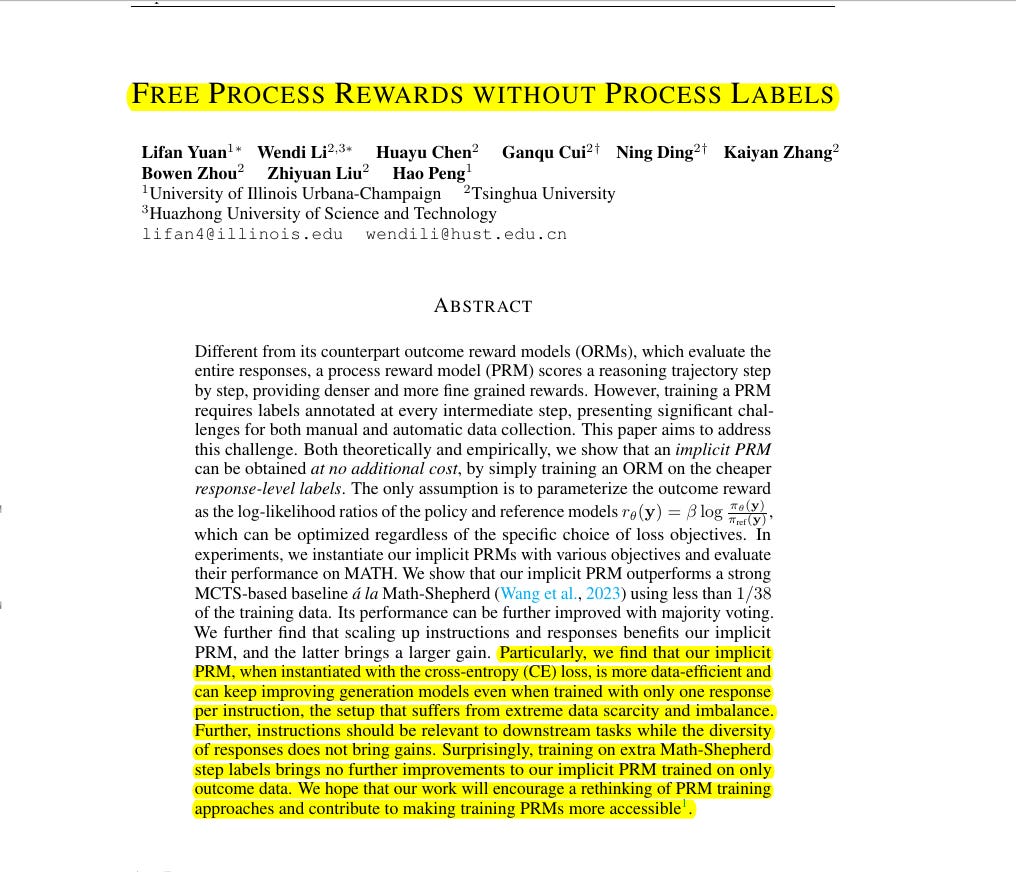📚 Learning From The Top Recent Great Math+Reasoning Papers - Is o1 Within Reach?
If you want your LLM to solve everything from Olympiad geometry to cutting-edge research math, the key is building exhaustive data sources and the right infrastructure to verify solutions at scale.
Recent strides in large language models (LLMs) reveal a common theme: to consistently solve advanced math problems, these models need more than just bigger parameter counts or new fine-tuning algorithms.
A key takeaway from multiple papers—
the right data, combined with robust infrastructure to gather or verify solutions, can be more determinative than fancy techniques. Below, we’ll explore the core ideas in these papers, see how they intersect, and highlight why data curation and step-level verification frameworks might hold the keys to bridging the gap up to the rumored “o1” model’s math prowess.
1. AceMath: Data-Centric Post-Training with Reward Models
Core Idea
AceMath focuses on building math-specialized models, presenting a new suite of advanced math models (AceMath-7B, 72B, etc.). Notably, the authors rely on both post-training on curated math data and reward modeling to filter out or weight correct solutions.
Key Innovations
Data Curation First: They gather a massive corpus of carefully checked math problems—from short arithmetic to challenging college-level questions—and then post-train base LLMs on it.
Reward Modeling: Instead of just focusing on step-level alignment, they emphasize outcome-based verifiers for final solutions. That said, they also incorporate step-level supervision in parts of their pipeline, but the big jump emerges once the model sees enough carefully filtered data in post-training.
Power of Synthetic: They highlight that large synthetic expansions of math prompts are possible, but they put robust effort into removing duplicates, controlling question difficulty, and verifying solutions so the model “learns from the right stuff.”
🔧 Specific methods in this Paper:
→ AceMath employs a two-stage supervised fine-tuning process that first builds general competency across domains.
→ The model then undergoes targeted math-specific fine-tuning using carefully curated prompts and synthetic responses.
→ A specialized reward model, AceMath-RM, evaluates solutions across diverse problems and difficulty levels.
→ The system combines instruction-tuned models with reward models to achieve superior mathematical reasoning.
Reflection
The strong performance improvements in AceMath do not come from a novel decoding or search trick. Rather, it’s from scaling up high-quality, well-verified math data plus a “noisy data cleanup,” ensuring the model’s internal representations align with correct mathematical reasoning. It underscores that a crucial bottleneck is still data curation, not an exotic new algorithm.
2. FrontierMath: A Benchmark to Stress-Test Advanced Reasoning
Core Idea
While AceMath tackled how to build stronger math LLMs, FrontierMath addresses evaluation. It introduces a large, carefully designed set of challenging math problems—covering topics from advanced geometry to graduate-level algebra—for which existing LLMs typically fail.
Key Innovations
Unpublished Hard Problems: By sourcing newly authored, highly difficult math questions from domain experts, FrontierMath avoids data contamination (where models see test questions during training).
Automated Verification: Each question has a code-based checker that either confirms correctness or rejects the solution. This style of “verifiable answer checking” ties in with the notion that step-level or outcome-level correctness can be automatically judged.
Data is the Challenge: Their results show that even the best open or closed LLMs achieve relatively low scores on FrontierMath. This gap emphasizes that model size or naive chain-of-thought often aren’t enough for these research-level tasks.
Reflection
FrontierMath’s authors point out that building huge, specialized data sets—and automated ways to verify solutions—is labor-intensive, but it is precisely this infrastructure that yields more honest evaluations. Their findings hint strongly that to reach top-tier performance (or “o1”), any LLM will likely need much more domain-specific data curation, beyond typical code or web crawls.
3. MindStar: Searching for Good Reasoning at Inference Time
Core Idea
Instead of heavy training, MindStar (M)* proposes a search-based approach at inference. You keep the LLM fixed (e.g., Llama-2), but you systematically prompt for partial steps, score them with a process reward model, and expand or backtrack in a tree-like structure until you find a correct final solution.
Key Innovations
Process Reward Model (PRM): They rely on a step-level reward function (trained on math solutions) to evaluate each intermediate step. The search algorithm (e.g., beam or best-first) picks the path with highest PRM-scores, effectively doing “stepwise reflection.”
No Full Fine-Tuning: By focusing on a reward model plus clever tree-of-thought expansions, MindStar can drastically boost math accuracy with minimal changes to the base LLM. This saves training overhead.
Scalability: They show that with 16–32 expansions, M* can outperform naive chain-of-thought by large margins. But the biggest cost is more tokens at inference time.
Quick Reflection
MindStar’s success once again highlights that “the LLM knows the right solution but fails to pick it.” So with a well-trained PRM (from robust data), you can surface correct solutions. This approach emphasizes the synergy between a strong “verifier” or “re-ranker” and a decent base LLM. The search method is less about novel generative algorithms and more about carefully orchestrating data usage at inference, plus building a robust reward model. The data used to train the PRM remains essential.
Why LLMs Fail Despite "Knowing" the Answer
LLMs are trained to predict the next token based on context, but when faced with multi-step reasoning (like math proofs), they struggle. Why? These models often generate plausible reasoning steps but lack the ability to “critique” or “re-rank” their outputs effectively. This leads to suboptimal answers, even if a correct path exists in the search space.
Process Reward Model (PRM) as a Powerful Verifier
The PRM acts as a filter—it evaluates and scores individual reasoning steps for their likelihood of correctness. Trained on curated data, the PRM doesn't just check isolated steps—it evaluates them in the context of the full reasoning trajectory. This makes the framework much stronger at discarding flawed partial answers early.
In simple terms:
The LLM generates multiple intermediate reasoning steps.
The PRM assigns a score to each.
The highest-scoring path is fed back for further expansion.
This turns the reasoning process into a feedback loop rather than a linear chain.
The Real Game-Changer: Data, Not New Algorithms
MindStar shows that the true power lies in robust data used to train the PRM. Rather than focusing on complex generative tweaks or model fine-tuning, the framework focuses on inference-time optimization. The PRM ensures that good solutions are surfaced from a pool of possible reasoning traces.
Key takeaway: even a mid-sized base LLM (like Llama-2-13B) can outperform much larger models (e.g., GPT-3.5) when paired with a strong PRM and an efficient search strategy like Levin Tree Search. This emphasizes that what matters isn’t just the size of the model, but how you leverage data for verification and ranking.
Orchestrating Data Usage at Inference
The success of this approach boils down to effective orchestration of computation at inference time:
Rather than blindly fine-tuning, MindStar maximizes the exploration of reasoning paths during inference.
It narrows down possible steps without wasting compute on unrelated trajectories.
This shift of effort from training to inference enables high performance with significantly fewer resources.
Closing Thought
MindStar’s lesson is clear: reasoning in LLMs isn’t about making models endlessly bigger—it’s about creating smarter workflows that combine generation and verification. The synergy between a decent base LLM and a strong verifier (trained on the right data) can unlock significant improvements in reasoning-heavy tasks, proving that the path to stronger AI reasoning lies in structured reflection, not brute-force generation.
4. Formal Mathematical Reasoning: A New Frontier in AI
Core Idea
This position paper advocates for using formal systems like proof assistants (Lean, Coq, Isabelle) as the environment for robust AI math. The authors note that verifying a proof with machine-checkable formal proofs is the gold standard for correctness.
Key Innovations
Formalization as Data: The biggest barrier, ironically, is that most mathematics is stated informally. Translating the entire corpus of advanced mathematics into formal languages is massive. So any real progress might be less about algorithmic improvements and more about collecting or generating high-quality formal corpora.
Step-Level or Tactic Guidance: Just as MindStar uses an external model to verify partial text solutions, formal mathematics uses theorem provers to confirm step validity.
Reward from Theorem Prover: They highlight that if the model “guesses” a step and the theorem prover says “this is valid,” the model can proceed. This direct feedback loop can be more valuable than any plain text reward.
Reflection
The authors repeatedly stress that building large enough formal proof corpora, or bridging “informal to formal” math text, is the main challenge. Reaching near-human or “o1” capabilities in advanced math demands enormous expansions in both data coverage and specialized infrastructure like formal verification systems.
5. Free Process Rewards Without Process Labels
Core Idea
This paper contends that training a step-level reward model is actually easier than many assume. By parameterizing the final outcome’s correctness in log-likelihood terms and reusing simpler outcome-level data, they show that you can produce process-level rewards “for free.”
Key Innovations
Implicit PRM: The “reward” for partial steps can be implicitly computed from the ratio of policy vs. reference likelihood. Therefore, you don’t necessarily need a huge step-labeled dataset if you have final correctness labels.
Less Data, More Gains: They show that if the model is decent at generating correct solutions, you can pivot that ability toward partial-step scoring. So the overhead of data labeling is smaller than one might guess—some final outcome labels suffice.
Reflection
While “step-labeled” data helps, they claim you can skip it entirely if your base LLM is already strong on final outcomes. The overarching pattern is that simple expansions of the final correctness labels, plus parameter re-interpretations, are enough to push step-level scores for free. Again, this underscores the fundamental role of data—here, the data is final correctness answers. The algorithm is basically a “smart usage” hack.
Converging on a Key Insight: Data & Infra vs. Algorithms
Despite differences in approach—post-training vs. inference-time searching vs. formal proof vs. step-labeled or outcome-labeled reward—the papers converge on the idea that amassing high-quality data and building robust “infrastructure” (be it formal verifiers or step-level reward scaffolding) is essential.
Why is “o1” still elusive? Each paper hints it’s not that a certain optimization or neural trick is missing. The largest leaps come from:
Extensive dataset curation (AceMath, FrontierMath).
Step-level or final solution verifiers, fed by carefully curated or filtered data (MindStar’s PRM, formal proofs).
Synthesis of new samples, but with robust checking methods to ensure data correctness (Free Process Rewards).
Hence, moving from standard LLM performance to an “o1-level” solver appears less about building one magical algorithm—like a new attention variant or chain-of-thought prompt—and more about forging the entire pipeline: verifying solutions, gleaning or generating high-quality expansions, pruning out half-baked content, and exploiting step-by-step reflection. That pipeline demands advanced data annotation, domain-specific coverage, or powerful universal verifiers.
Ultimately, as of now, these papers imply that if you want your LLM to solve everything from Olympiad geometry to cutting-edge research math, the key is building exhaustive data sources and the right infrastructure to verify solutions at scale. Subpar results typically reflect not “bad algorithms,” but incomplete or insufficient data coverage. Meanwhile, new search or verification algorithms do help, but they flourish only when the data foundation is strong.
Conclusion
All these papers reaffirm a central principle: to push LLMs closer to “o1 math reasoning,” we must invest heavily in data curation and robust scaffolding rather than expecting a purely algorithmic fix. Whether it’s AceMath’s reward-model–enhanced fine-tuning, FrontierMath’s curated challenge set, MindStar’s inference-time search with a step-level reward, formal methods that rely on theorem provers, or “free process reward” solutions that pivot final correctness into partial-step feedback—every path revolves around the careful use of verified, high-value data.







